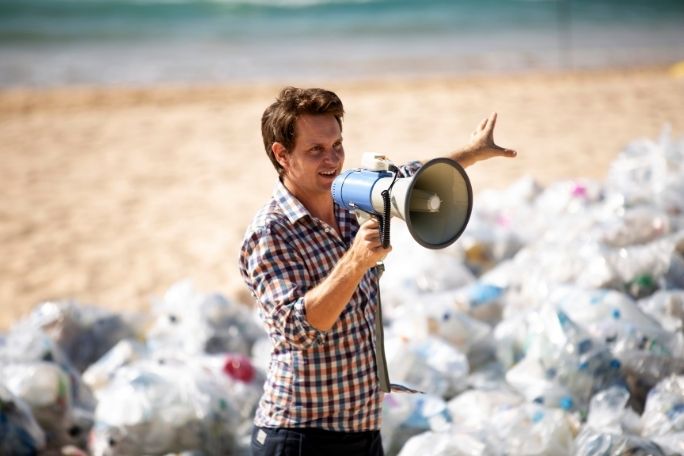Lesson summary
Students explore single-use plastics. They begin by defining the term ‘single-use plastics’ and suggesting examples of single-use plastics. Students then explore some of the impacts of single-use plastics on our environment, including the Great Pacific Garbage Patch and the impacts of microplastics. Students then focus on plastic water bottles and investigate why people choose to drink bottled water rather than tap water, before working collaboratively to create and share a tap water campaign.
Learning intentions:
Students will...
- understand what single-use plastics are and how they impact our environment
- understand what the Great Pacific Garbage Patch is and what microplastics are
- recognise that tap water is cheaper and more environmentally friendly than bottled water.
Success criteria:
Students can...
- work independently and collaboratively
- conduct and communicate research
- participate in class and group discussions
- think critically and creatively about a range of serious environmental issues.
Lesson guides and printables
Curriculum links
Select your curriculum from the options below.
Lesson details
Curriculum mapping
Australian curriculum content descriptions:
Year 4 Science:
- Natural and processed materials have a range of physical properties that can influence their use (ACSSU074)
- Science knowledge helps people to understand the effect of their actions (ACSHE062)
- Represent and communicate observations, ideas and findings using formal and informal representations (ACSIS071)
Year 4 HASS:
- The use and management of natural resources and waste, and the different views on how to do this sustainably (ACHASSK090)
- Present ideas, findings and conclusions in texts and modes that incorporate digital and non-digital representations and discipline-specific terms (ACHASSI082)
Year 5 Science:
- Scientific knowledge is used to solve problems and inform personal and community decisions (ACSHE083)
- Communicate ideas, explanations and processes using scientific representations in a variety of ways, including multi-modal texts (ACSIS093)
Year 5 HASS:
- The environmental and human influences on the location and characteristics of a place and the management of spaces within them (ACHASSK113)
- Present ideas, findings, viewpoints and conclusions in a range of texts and modes that incorporate source materials, digital and non-digital representations and discipline-specific terms and conventions (ACHASSI105)
Year 6 Science:
- OPTIONAL – Identify, plan and apply the elements of scientific investigations to answer questions and solve problems using equipment and materials safely and identifying potential risks (ACSIS103)
- Communicate ideas, explanations and processes using scientific representations in a variety of ways, including multi-modal texts (ACSIS110)
Syllabus outcomes: ST2-13MW, ST2-11LW, ST2-4WS, ST3-7PW, ST3-4WS, GE2-2, GE2-3, GE2-4, GE3-2, GE3-3, GE3-4
General capabilities: Critical and Creative Thinking
Cross-curriculum priority: Sustainability OI.3, OI.7, OI.9
Relevant parts of Year 4 Science achievement standards: Students apply the observable properties of materials to explain how objects and materials can be used, and they identify when science is used to understand the effect of their actions. They use formal and informal ways to communicate their observations and findings.
Relevant parts of Year 4 HASS achievement standards: Students identify the interconnections between components of the environment and between people and the environment
Relevant parts of Year 5 Science achievement standards: Students discuss how scientific developments help us solve problems. They communicate their ideas and findings using multi-modal texts.
Relevant parts of Year 5 HASS achievement standards: Students identify and describe the interconnections between people and the human and environmental characteristics of places, and present findings and ideas in a range of communication forms.
Relevant parts of Year 6 Science achievement standards: Students collect, organise and interpret their data and construct multi-modal texts to communicate ideas, methods and findings
Topic: Waste, sustainability
This lesson is part of the wider unit of work: War On Waste – Years 4-6
Time required: 80+ minutes
Level of teacher scaffolding: Medium – facilitate discussions and class activities, oversee group work and research activities, supervise water bottle challenge
Resources required
- Device capable of presenting an online clip to the class
- Great Pacific Garbage Patch Factsheet
- Microplastics Factsheet
- Microplastics Science Activity – Year 6
- Single-use Plastics Images
- Student Worksheet – one copy per student
Skills
This lesson is designed to build students’ competencies in the following skills:
- Communication
- Community engagement
- Collaboration
- Critical thinking
Additional info
Cool Australia’s War On Waste lessons have been developed in partnership with Lune Media and with support from the Australian Environmental Grantmakers Network. These lessons have been designed to lead students through a deeper understanding of some of the big issues relating to waste in Australia and to support them to take action to reduce the impact of waste on our environment.


Welcome back!
Don't have an account yet?
Log in with:
Create your free Cool.org account.
Many of our resources are free, with an option to upgrade to Cool+ for premium content.
Already have an account?
Sign up with:
By signing up you accept Cool.org's Terms and Conditions(Opens in new tab) and Privacy Policy(Opens in new tab).